The Australian Dollar Surges on Trade Boon and RBA Patience
- Written by: James Skinner
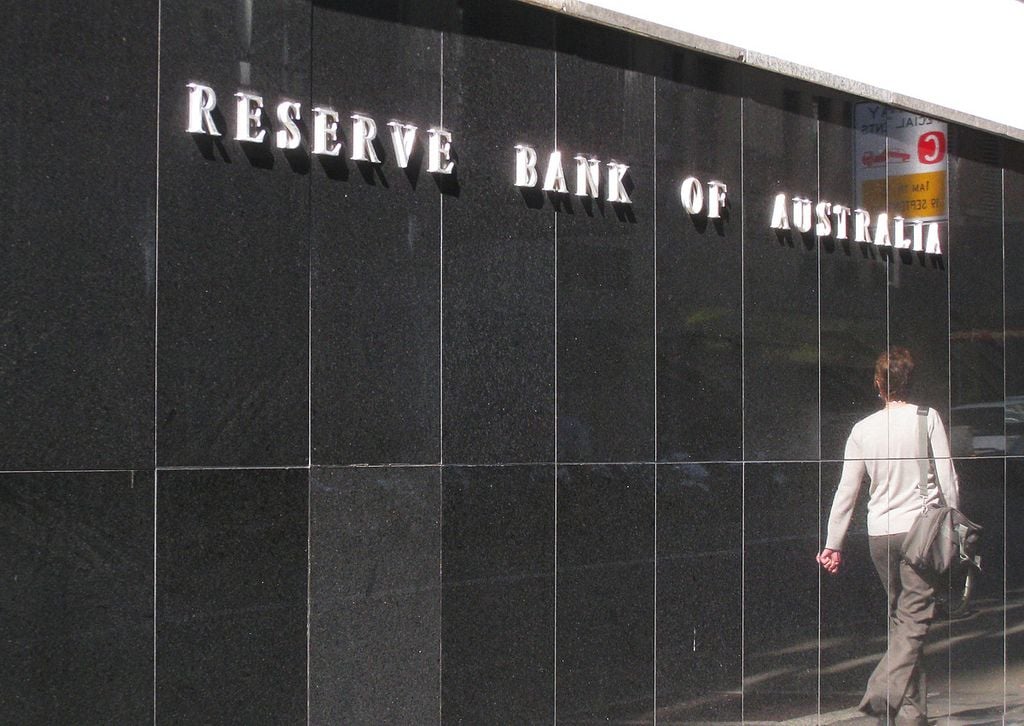
Image © Newtown Grafitti, Reproduced under CC Licensing.
- AUD tops G10 league table on trade surplus surprise, RBA patience.
- Strong export growth, weak imports, produce another record surplus.
- Trade data offers scope for 1st current account surplus since 1970s.
- RBA remains patient but market continues to bet on further rate cut.
- AUD boost comes amid elevated U.S.-China tensions, litany of risks.
The Australian Dollar surged higher against its G10 rivals Tuesday after the Reserve Bank of Australia (RBA) suggested it will wait for some time before cutting its interest rate again and as markets serenaded a record trade surplus for the month of June.
Australia's trade surplus came in at $8.04 bn for June, which is up 30% from the previous month and a new record high, according to the Australian Bureau of Statistics. This was the result of export growth as well as a decline in imports during the recent month.
Commodity prices have risen in 2019, especially that of iron ore, which is Australia's single largest export and has likely boosted the monetary value of Australia's trade with the rest of the world. Meanwhile, economic weakness and lacklustre consumer spending may have constrained imports.
"The key positive was iron ore, which rose further on the spike in global prices following the supply shock in Brazil," says Andrew Hanlan at Westpac. "Imports provided the main surprise, pulling-back by 3.6%...This suggests a drop in volumes in the month against the backdrop of sluggish domestic demand."
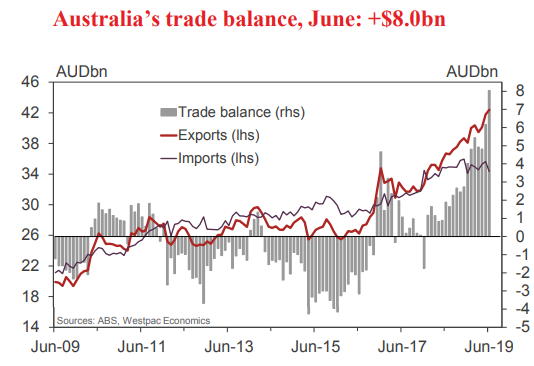
Above: Westpac graph showing Australian trade statistics and balance.
Trade balance data measures changes in imports and exports, which are important to markets not only because they represent real world supply and demand growth for a currency but also because they're key factors in the calculation of GDP. Imports represent supply of a currency hitting the global market and are a subtraction in the calculation of GDP while exports represent demand for a currency and are an addition in the calculation of GDP.
Trade balance numbers are one of many important components in a current account balance, which measures the flow of funds into and out of an economy while also providing an indication of the extent to which a country is reliant on borrowing from the rest of the world. A country that is reliant on borrowing from the rest of the world in order to plug a current account deficit can be left exposed to the changing whims and sentiments of international investors.
"This record shattering surplus creates a material possibility for a current account surplus for the June quarter. This would be the first current account surplus since the 1970s," says David Plank, head of Australian economics at ANZ. "Looking forward, further record surpluses are possible if resource exports hold up and imports continue to fall. Some moderation seems more likely."
Tuesday's data, and the prospect of Australia's current account returning to surplus after many decades in deficit, offers scope for a material improvement in the fundamental value of the Australian Dollar. This lit a proverbial fire beneath Aussie Dollar exchange rates Tuesday.
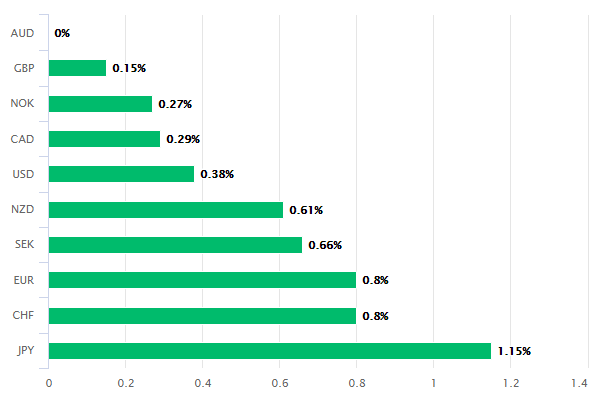
Above: Australian Dollar performance Vs G10 rivals Tuesday. Source: Pound Sterling Live.
The Aussie Dollar also received a boost from the Reserve Bank of Australia during the morning session. Australia's cash rate was left unchanged at 1% for August on Tuesday although Governor Philip Lowe says the bank will monitor developments in the economy over the coming months and "ease monetary policy further if needed" to support sustainable economic growth that lifts the inflation rate above the elusive midpoint of the 1%-to-3% target.
Lowe also said reiterated that it would be reasonable for markets to expect "an extended period of low interest rates" ahead as the bank attempts to meet its inflation target. The RBA has already cut its cash rate twice in 2019, from 1.5% at the beginning of the year, after a slowdown in the domestic and global economies threatened to put attainment of the bank's inflation target even further from view. Inflation has not been above the 2% target for any meaningful period of time since 2012.
Changes in rates are normally only made in response to movements in inflation, which is sensitive to growth, but impact currencies because of the push and pull influence they have over capital flows. Those flows tend to move in the direction of the most advantageous or improving returns, with a threat of lower rates normally seeing investors driven out of and deterred away from a currency.
"Our yield-differential model suggests that the Aussie is undervalued against the dollar and that fair valuation is currently closer to the 0.7000 level it held against the US dollar before its recent decline in July. The Relative Strength Index above indicated yesterday that a turnaround could be expected – it was the most oversold of the G10 currencies," says Fritz Luow, an analyst at MUFG.
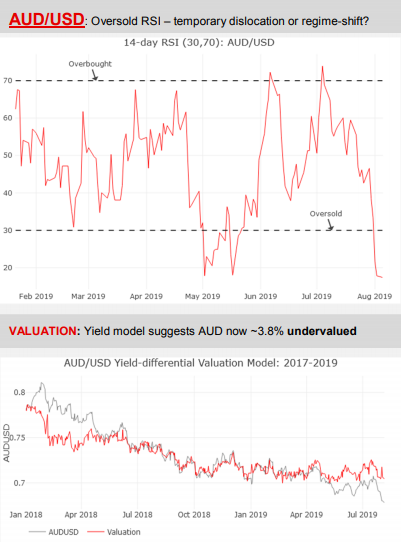
Above: Australian Dollar valuation and relative-strength-index. Source: MUFG.
Speculation in the runup to those earlier rate cuts badly damaged the Australian Dollar although financial markets have since moved ahead of the RBA and priced-in a further one rate cut for 2019, which is why the Aussie no longer declines when the bank now talks of lower rates.
Tuesday's statement did little to dissuade the market of the view that RBA policymakers will likely cut the cash rate again later this year, although it does create scope for a possible run of positive economic data to delay a third cut for longer than investors anticipate, which would be positive for the Aussie.
The AUD/USD rate was quoted 0.36% higher at 0.6787 during the morning session Tuesday but is still down 3.7% for 2019, while the Pound-to-Australian-Dollar rate was 0.02% higher at 1.7979 but has fallen 0.65% this year.
"We continue to expect the RBA to cut again in November, but we certainly can't rule out the chance of an earlier cut. OIS markets kept pricing for an October cut at around 90%," says Ned Rumpelting, head of European FX strategy at TD Securities. "AUDUSD has stabilized just above the 3 January 'flash crash' low at 0.6741. This is now the primary pivot level. It will depend greatly on broader risk appetite, but the conditions could now be in place for a modest squeeze higher."
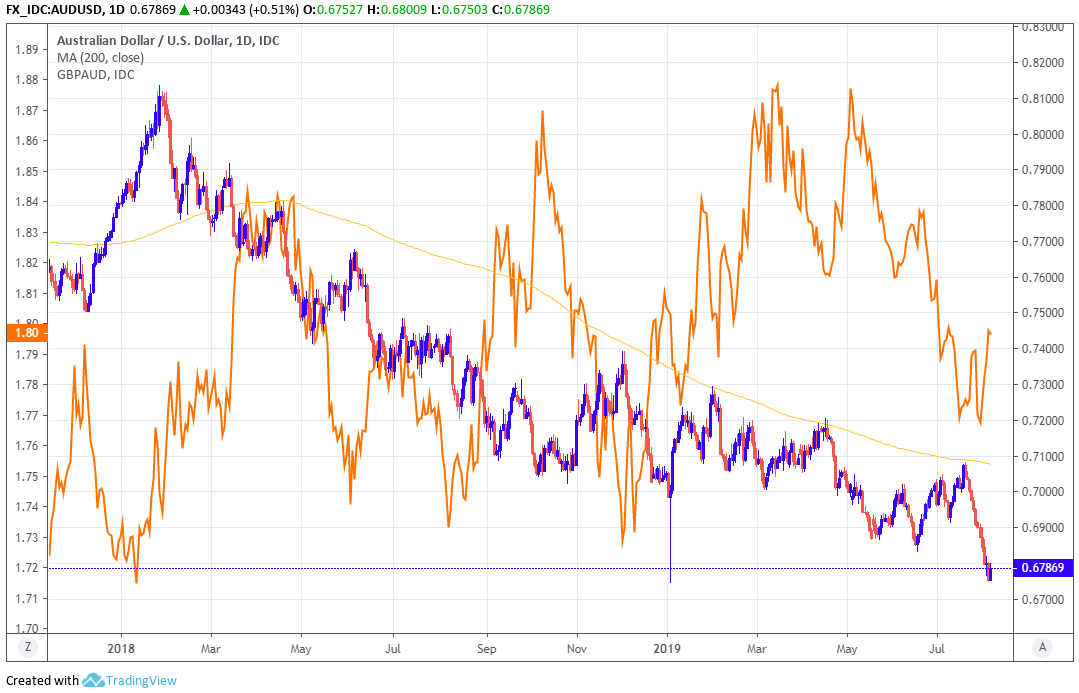
Above: AUD/USD at daily intervals alongside Pound-to-Australian-Dollar rate (orange line, left axis).
"The PBoC does not mind letting the yuan weaken, but would still want to smooth market movement. Tuesday’s USD/CNY fixing was 6.9683, up from 6.9225 on Monday but importantly, below 7.00 (and the spot close of 7.0507)," says Francis Cheung at Westpac. "The chances of another round of trade talks near-term look slim."
Tuesday's data and policy update came amid an escalation of the trade war between the U.S. and China that has also repeatedly hurt the Aussie Dollar in recent months because of Australia's significant trade relationship with China and its economic exposure to commodity prices, which fluctuate in line with the changes in the outlook for the global growth that is now being threatened by the spat between the world's two largest economies.
The U.S. Treasury Department labelled China a 'currency manipulator' this week after the People's Bank of China (PBOC) set its 'fixing' for the USD/CNY rate a touch lower following President Donald Trump's decision to impose fresh tariffs on the country's exports to the U.S. There are no direct implications for China or the Aussie from the new designation alone although many analysts say a continuation of the trade war won't be good for the Australian Dollar.
"It essentially means that the US can pursue avenues to stop the currency manipulation process. The most likely avenue the US President will pursue is to have the IMF instruct China to report more details on their currency reserves management," says Richard Grace at Commonwealth Bank of Australia. "We do see a risk AUD/USD is dragged lower if the downside risks for CNY listed above eventuate and USD/CNY continues to lift well above 7.0000."
Time to move your money? Get 3-5% more currency than your bank would offer by using the services of foreign exchange specialists at RationalFX. A specialist broker can deliver you an exchange rate closer to the real market rate, thereby saving you substantial quantities of currency. Find out more here.
* Advertisement




